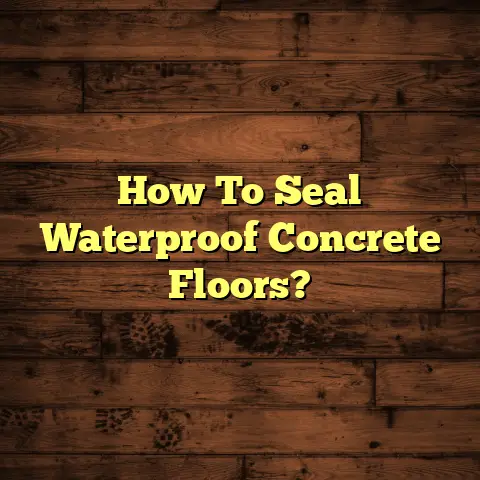Vinyl Flooring Off-Gassing Time? (Under 72 Hrs?)
Imagine your home as a living, breathing
organism.
It inhales and exhales, and the
materials we bring inside, like vinyl
flooring, impact its respiratory system.
Think of that “new car smell.” That’s
off-gassing!
It’s the release of chemicals
from materials, and it fades over time.
Vinyl flooring is super popular these days,
but there’s buzz about its off-gassing.
As
a flooring contractor for over 15 years, I’ve
seen homeowners concerned about this.
This article will explore the timeline of
off-gassing in vinyl flooring and what it
means for you and your family.
We’ll dive
into how long it lasts, what impacts it, and
how to minimize any potential issues.
Let’s get started!
Section 1: Understanding Off-Gassing
So, what exactly is off-gassing?
Simply put, it’s when materials release
chemicals into the air.
Many building
materials do it, but vinyl flooring gets a
lot of attention.
With vinyl, the main culprits are volatile
organic compounds (VOCs) and sometimes
phthalates.
VOCs are used in the
manufacturing process, as solvents or
plasticizers.
Phthalates are sometimes
used to make the vinyl more flexible.
Where do these chemicals come from?
Well,
it depends on the specific flooring product.
Some manufacturers use more of certain
chemicals than others.
Why does off-gassing happen?
Think of it
this way: the chemicals are trapped inside
the flooring during manufacturing.
Over
time, they escape into the air.
This process is sped up by factors like
temperature and humidity.
The warmer it is,
the faster the chemicals evaporate.
Newer
flooring tends to off-gas more than older
flooring.
Section 2: The Timeline of Off-Gassing
Okay, let’s get to the big question: how long does vinyl flooring off-gas?
The common belief, and what I’ve seen in
the field, is that the majority of
off-gassing happens within the first 72
hours.
However, it can linger longer,
sometimes for weeks or even months,
depending on the product.
I’ve read studies that support this 72-hour
window.
For example, tests by the EPA have
shown VOC emissions from building materials
decrease significantly after the first few
days.
(Source: EPA Indoor Air Quality
Website).
But here’s the thing: it varies.
Sheet
vinyl, vinyl tiles, and luxury vinyl plank
(LVP) can all have different off-gassing
times.
LVP, especially thicker planks,
might off-gas for a bit longer due to the
increased material.
I had a client once, Sarah, who was
super-sensitive to smells.
We installed new
LVP in her living room, and even after a
week, she could still detect a slight odor.
We cranked up the ventilation, and it
eventually dissipated, but it definitely
took longer than 72 hours.
Another factor is the manufacturing
location and standards.
Flooring made in
countries with stricter environmental
regulations often has lower VOC emissions.
Here’s a table summarizing the factors affecting off-gassing time:
Remember, these are general guidelines. Always check the manufacturer’s specifications for your specific product.
Section 3: Health Implications of Off-Gassing
Now, let’s talk about the potential health
effects.
It’s important to be informed, but
also to keep things in perspective.
VOCs can cause a range of symptoms, from
mild irritation like headaches and nausea to
more serious respiratory issues.
The
severity depends on the type and
concentration of VOCs, and your individual
sensitivity.
Children and individuals with respiratory
problems, like asthma, are often more
vulnerable to the effects of VOC exposure.
Their bodies are still developing, or their
respiratory systems are already compromised.
Short-term exposure might cause eye, nose,
and throat irritation.
Long-term exposure,
while less common with modern vinyl
flooring, has been linked to more serious
health problems in some studies.
The key is indoor air quality.
Off-gassing
can contribute to poor air quality, but
it’s usually just one factor among many.
Things like cleaning products, furniture,
and even cooking can also release VOCs.
According to the American Lung Association,
reducing VOC exposure is important for
maintaining healthy indoor air.
(Source:
American Lung Association Website).
I always advise my clients to be proactive
about ventilation, especially after
installing new flooring.
It’s a simple way
to minimize potential health risks.
Section 4: Mitigating Off-Gassing
So, what can you do to reduce off-gassing from your new vinyl flooring?
First and foremost: ventilation!
Open
windows and doors during and after
installation.
Use fans to circulate the air.
The more fresh air, the better.
I often recommend running an air purifier
with a HEPA filter and activated carbon.
The
HEPA filter traps particles, while the
activated carbon absorbs VOCs.
Consider low-VOC or VOC-free flooring
options.
Many manufacturers now offer these
products, which are made with fewer
harmful chemicals.
Look for certifications
like FloorScore or GreenGuard.
Acclimating the flooring before
installation can also help.
Unpack the
flooring and let it sit in a well-ventilated
area for a few days.
This allows some of
the VOCs to escape before the flooring is
installed.
Here’s a quick checklist for mitigating off-gassing:
- Ventilate!
- Use an air purifier.
- Choose low-VOC flooring.
- Acclimate the flooring beforehand.
- Clean with VOC-free products after installation.
I had a client, Tom, who was really worried
about off-gassing because he had a young
child.
We chose a FloorScore-certified LVP
and made sure to ventilate the house
thoroughly during and after installation.
He
felt much more comfortable knowing we had
taken extra precautions.
Section 5: Consumer Awareness and Choices
Consumer awareness is key when it comes to
choosing flooring materials.
You have the
power to make informed decisions that
prioritize your health and the environment.
Pay attention to labeling practices.
Look
for certifications that indicate low VOC
levels, like FloorScore, GreenGuard, or
CRI Green Label Plus.
These certifications
mean the product has been tested and meets
certain standards for emissions.
Do your research!
Don’t just rely on the
salesperson’s word.
Read reviews, compare
products, and ask questions about the
materials used and the manufacturing
process.
Many manufacturers now publish detailed
information about their products’ VOC
emissions.
This information is often
available on their website or by request.
When choosing flooring, think about your
values.
Do you want a product that is
eco-friendly?
Do you have sensitivities to
certain chemicals?
These are important
questions to consider.
I encourage my clients to ask me about VOC
emissions and certifications.
I’m always
happy to provide information and help them
make the best choice for their needs.
Here are some questions to ask when choosing vinyl flooring:
- What is the VOC content of this product?
- Does this product have any certifications for low emissions?
- Where was this product manufactured?
- What type of adhesive is recommended for
installation, and does it have low VOCs?
By being informed and asking the right questions, you can create a healthier and more comfortable living environment for yourself and your family.
Conclusion
Understanding off-gassing empowers you to
make informed choices about your flooring.
It’s about creating a healthy home
environment where you can breathe easy.
Remember, the majority of off-gassing from
vinyl flooring typically occurs within the
first 72 hours.
But factors like flooring
type, ventilation, and manufacturing
standards can affect the timeline.
Choosing low-VOC options, ventilating properly, and being aware of the potential health implications can make a big difference.
Think of your flooring as part of your
home’s atmosphere.
Choosing wisely is like
choosing what you breathe in.
Make it a
choice that supports your health and
well-being.





